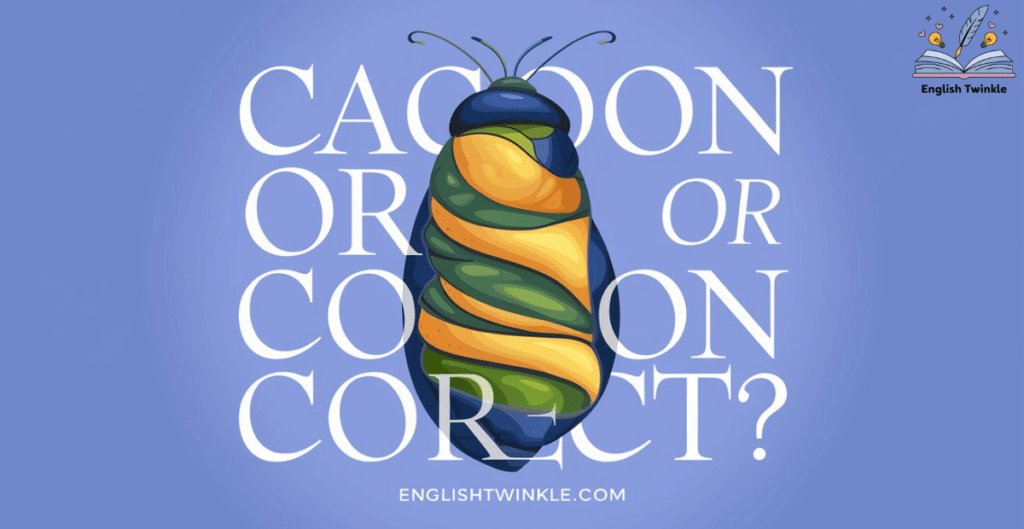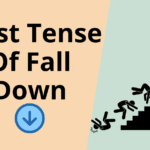In the vast and intricate realm of the English language, spelling confusion often arises, even among native speakers. One such perplexing pair of words is “cacoon” and “cocoon.” This article delves deep into the heart of this spelling conundrum, exploring the correct usage, meanings, and fascinating facts surrounding these terms. We’ll journey through the worlds of entomology and botany, uncover the origins of these words, and provide you with foolproof methods to remember the correct spelling. Let’s embark on this linguistic adventure and solve the mystery of cacoon vs. cocoon once and for all.
The Root of Confusion: Why Do People Mix Up Cacoon and Cocoon?
Before we dive into the specifics, it’s crucial to understand why this spelling confusion exists in the first place. Several factors contribute to this common error:
- Visual Similarity: The words “cacoon” and “cocoon” look remarkably similar, differing only by one letter.
- Phonetic Resemblance: Both words are pronounced similarly, making it easy to mishear or misspell.
- Common Misspelling Trends: English is notorious for its spelling irregularities, and “cacoon” falls into a pattern of common errors.
- Lack of Familiarity: Many people don’t encounter the word “cocoon” frequently in their daily lives, leading to uncertainty about its correct spelling.
- Regional Variations: In some dialects, the pronunciation might further blur the distinction between “ca-” and “co-” sounds.
“To err is human, to really foul things up requires a computer.” – Paul Ehrlich
This quote reminds us that while humans make mistakes, it’s our responsibility to learn and improve. Let’s do just that by exploring the correct spelling and usage of these terms.
Cocoon: The Correct Spelling and Its Rich Meanings
Cocoon is the correct spelling, and it’s a word with multiple fascinating definitions and applications. Let’s break it down:
Cocoon Definition in Entomology
In the world of insects, a cocoon refers to a protective casing that certain insects, particularly moths and butterflies, create during their pupal stage. This insect shelter plays a crucial role in the process of metamorphosis.
Key Facts About Insect Cocoons:
- Made of silk produced by the insect
- Provides protection during the vulnerable pupal stage
- Can vary greatly in size, shape, and colour depending on the species
- Some cocoons are camouflaged to blend with their surroundings
- Not all insects form cocoons; some have exposed pupae or chrysalises
The Science Behind Cocoon Formation
The process of cocoon formation is a marvel of nature:
- Silk Production: Caterpillars have special glands called silk glands that produce liquid silk.
- Spinning: As the liquid silk is exposed to air, it hardens into a fiber. The caterpillar uses its mouthparts to spin this fiber.
- Construction: The caterpillar wraps the silk around itself, layer by layer, forming the cocoon.
- Hardening: The silk hardens further, creating a tough protective shell.
- Metamorphosis: Inside the cocoon, the caterpillar transforms into a pupa and then an adult insect.
Cocoon in Metaphorical Context
Beyond its literal meaning, “cocoon” has taken on rich metaphorical significance in our language. In figurative language, a cocoon often symbolises:
- A place of safety or comfort
- A state of transformation or personal growth
- Isolation or seclusion from the outside world
- A protective barrier against external influences
“We are all butterflies. Earth is our cocoon.” – LeeAnn Taylor
This metaphorical usage highlights how deeply the concept of a cocoon has embedded itself in our cultural consciousness.
Cocoon in Popular Culture
The term has found its way into various aspects of popular culture:
- Movies:
- “Cocoon” (1985) – A science fiction film about rejuvenation
- “The Cocoon and the Butterfly” (2020) – A documentary about transformation
- Music:
- “The Cocoon” by Simon & Garfunkel
- “Cocoon” by Milky Chance
- Literature:
- Often used as a symbol of transformation in poetry and prose
- Featured in children’s books about insect life cycles
Cocoon in Technology and Design
The concept of a cocoon has inspired various technological and design innovations:
- Automotive: Cocoon-inspired safety systems in cars
- Architecture: Cocoon-like structures for unique living spaces
- Furniture Design: Cocoon chairs and beds for cozy, enclosed relaxation
- Sleep Technology: Cocoon-inspired sleep pods for power napping
Cacoon: The Misspelling and Its Unexpected Twist

While “cacoon” is generally considered a misspelling, there’s an interesting twist to this story. Let’s explore:
Cacoon as a Botanical Term
Surprisingly, “cacoon” does have a legitimate use, albeit in a completely different context from insect metamorphosis. In botany, cacoon (also spelled “cacoon” or “kakoon”) refers to a specific tropical bean plant.
Cacoon Plant Details:
- Scientific Name: Fevillea cordifolia
- Common Names: Antidote cacoon, Sequa
- Family: Cucurbitaceae (cucumber family)
- Native Region: Tropical Americas
- Plant Description: A woody vine with large, round fruits containing flat seeds
This plant is known for its large, woody fruits containing flat seeds, which have been used in traditional medicine in some cultures.
|
A Quick Tip to Pick the Right Word: |
Traditional Medicinal Uses of Cacoon
In various parts of the Caribbean and South America, the cacoon plant has been used in traditional medicine:
- Antidote: The seeds were believed to counteract certain poisons.
- Digestive Aid: Used to treat various digestive issues.
- Pain Relief: Applied topically for joint pain and inflammation.
- Fever Reduction: Preparations from the plant were used to reduce fevers.
It’s important to note that while these traditional uses exist, scientific research on the efficacy and safety of cacoon-based treatments is limited.
Comparison Table: Cocoon vs. Cacoon
| Aspect | Cocoon (Insect-related) | Cacoon (Plant-related) |
|---|---|---|
| Definition | Protective casing for pupal stage | Tropical bean plant |
| Origin | French “cocon” | Possibly from a Native American language |
| Primary Use | Insect transformation | Traditional medicine, ornamental |
| Correct Spelling | Always “cocoon” | “Cacoon” or “kakoon” acceptable |
| Scientific Context | Entomology | Botany |
| Physical Form | Silky protective case | Woody vine with large fruits |
| Global Recognition | Widely known | Less common, regionally specific |
The Impact of Misspelling: Why Correct Spelling Matters
Using “cacoon” when you mean “cocoon” can lead to several issues:
- Miscommunication: In scientific or educational contexts, this error could cause significant confusion.
- Professionalism: Incorrect spelling can reflect poorly in professional settings.
- Search Engine Optimisation: Misspellings can affect online visibility and search-ability.
- Academic Integrity: In scholarly work, spelling errors can undermine credibility.
- Language Learning: For non-native speakers, encountering misspellings can hinder proper language acquisition.
To avoid these pitfalls, it’s crucial to use the correct spelling based on your intended meaning.
Fascinating Facts About Cocoons in Nature
Let’s delve deeper into the world of cocoons and discover some remarkable facts:
- Silk Production: The silkworm (Bombyx mori) produces one of the most economically important cocoons, used in silk production.
- Diversity: Some cocoons are made of silk. Some caterpillars use leaves, twigs, or even their own hair to construct cocoons.
- Size Variation: Some tiny parasitic wasps spin the smallest known cocoons, measuring less than 1mm, while other insects craft giant cocoons stretching over 10cm long!.
- Duration: The time spent in a cocoon varies greatly among species, from a few days to several months.
- Protective Mechanisms: Some cocoons have built-in chemical defences or mimicry to deter predators.
- Underwater Cocoons: Certain aquatic insects, like caddisflies, create cocoon-like structures underwater.
- Communal Cocoons: Some caterpillar species form communal cocoons, with multiple individuals pupating together.
- Cocoon Recycling: In some species, adult females lay their eggs on or near their own cocoons, providing ready-made shelters for their offspring.
- Temperature Regulation: Cocoons can help regulate temperature, protecting the pupa from extreme heat or cold.
- Human Uses: Beyond silk production, some cultures use cocoons for jewellery, decorations, and even as natural sponges.
The Evolutionary Significance of Cocoons
The development of cocoons represents a significant evolutionary adaptation:
- Protection: Cocoons shield vulnerable pupae from predators and harsh environmental conditions.
- Energy Conservation: By remaining immobile in a cocoon, insects conserve energy for the dramatic transformation process.
- Metamorphosis Support: The enclosed environment of a cocoon provides ideal conditions for the complex process of metamorphosis.
- Ecological Niche Expansion: Cocoons allow insects to survive in a wider range of habitats and climates.
- Diversification: The variety of cocoon types has contributed to the incredible diversity of insect species we see today.
Tips for Remembering the Correct Spelling
To avoid falling into the cacoon vs. cocoon trap, try these memory aids:
- Double O Rule: Remember that “cocoon” has a double “o”, just like in “moon” or “balloon”.
- Etymology: Recall its French origin “cocon” to reinforce the “co-” beginning.
- Visualisation: Picture two round “o”s nestled in the middle of the word, like eggs in a nest.
- Mnemonic Device: “Caterpillars Create Cocoons for Complete Change”
- Word Association: Link “cocoon” with “cartoon” – both have the “coo” sound in the middle.
- Rhyme Method: “The baboon swoons in its cocoon under the moon.”
- Spelling Bee Technique: Break the word into syllables: co-coon.
|
Quick Summary: |
Case Study: The Silk Industry and Cocoons
The silk industry provides a perfect example of the economic importance of cocoons:
- Annual Production: Over 200,000 metric tons of silk produced worldwide
- Primary Producers: China, India, Uzbekistan
- Process:
- Farmers harvest silkworm cocoons
- Workers boil cocoons to kill the pupa
- Skilled operators carefully unwind the silk
- Technicians twist multiple strands together to form thread
- Weavers create fabric from the thread
- Sustainability Concerns: Efforts are being made to develop more ethical silk production methods, including:
- “Peace silk” or “Ahimsa silk,” where moths are allowed to emerge before the cocoons are harvested
- Development of synthetic alternatives to reduce reliance on silkworm cocoons
This case study illustrates the significant role cocoons play not just in nature, but in human industry as well.
The Future of Cocoon-Inspired Technology

Scientists and engineers are increasingly looking to nature for inspiration, and cocoons are no exception:
- Biomimetic Materials: Researchers are developing new materials inspired by the structure and properties of natural cocoons.
- Medical Applications: Scientists are exploring cocoon-like structures to create innovative drug delivery systems and tissue engineering scaffolds.
- Aerospace Innovation: The lightweight yet strong properties of cocoons are inspiring new designs in aircraft and spacecraft materials.
- Sustainable Packaging: Biodegradable packaging materials based on cocoon structures could help reduce plastic waste.
- Smart Textiles: Innovators are developing smart textiles with cocoon-like protective properties, revolutionising everything from outdoor gear to military uniforms..
Conclusion: Embracing Linguistic Precision and Natural Wonder
In conclusion, while “cacoon” and “cocoon” may seem interchangeable at first glance, they represent distinct concepts. “Cocoon” is the correct spelling for the protective casing created by insects, as well as for metaphorical uses. “Cacoon,” on the other hand, is primarily a botanical term referring to a specific tropical plant.
By understanding these differences, we not only improve our language skills but also gain insight into the fascinating worlds of entomology and botany. The journey from spelling confusion to clarity has taken us through diverse fields of study, from linguistics to evolutionary biology, from traditional medicine to cutting-edge technology.
The humble cocoon, a simple protective casing in nature, has inspired human innovation, language, and culture in myriad ways. It serves as a powerful reminder of the interconnectedness of language, science, and the natural world.
Remember, precision in language opens doors to clearer communication and deeper understanding. Whether you’re writing about the miraculous transformation of a butterfly, discussing the silk industry, exploring tropical flora, or drawing inspiration from nature’s designs, knowing the correct spelling and usage of these terms will serve you well.
So next time you encounter a cocoon – be it in nature, in writing, or as a metaphor for transformation – you’ll not only know how to spell it correctly but also appreciate the rich tapestry of knowledge and wonder it represents. Let this exploration of “cacoon” and “cocoon” serve as a reminder of the endless discoveries awaiting us when we pay close attention to the details of language and the marvels of the natural world.

Freck John, linguist and English educator, shares grammar insights and writing tips at English Twinkle, making language concepts accessible to all learners.







